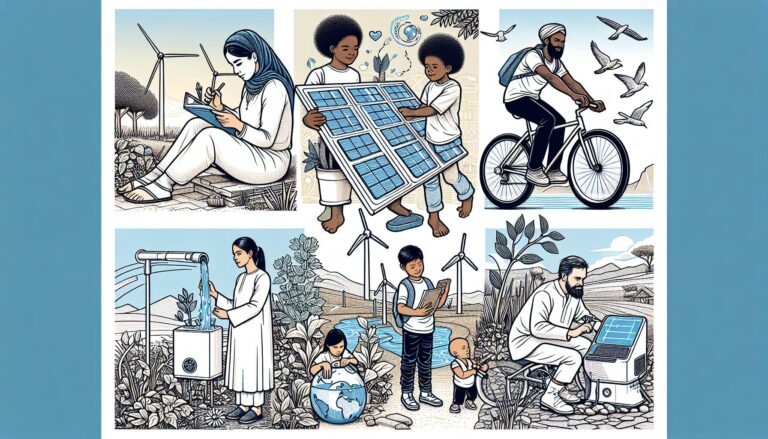In a cluttered world, finding simplicity can be the key to unlocking productivity. As I’ve discovered through my own journey, embracing minimalism isn’t just about decluttering physical spaces; it’s about decluttering the mind. By focusing on what truly matters and eliminating distractions, I’ve witnessed a significant boost in my efficiency and effectiveness.
Minimalism isn’t about deprivation; it’s about intentional living. In this article, I’ll share how adopting a minimalist mindset has transformed my approach to work and life. From streamlining workflows to reducing decision fatigue, the principles of minimalism have empowered me to achieve more with less.
Join me as I delve into the powerful connection between minimalism and productivity, and learn how simplifying your surroundings and mindset can pave the way for a more focused and fulfilling life.
Understanding Minimalism and Its Core Principles
Embracing minimalism goes beyond decluttering physical spaces; it’s a mindset shift towards intentional living. By focusing on essentials, I’ve found increased efficiency and effectiveness in my work and daily life.
Core principles of minimalism include:
- Simplicity: Prioritizing what truly matters
- Intentionality: Being mindful of possessions and commitments
- Quality over quantity: Choosing value over excess
Minimalism isn’t about sacrificing things; it’s about optimizing them for a purpose-driven life. By understanding these principles, I’ve been able to streamline tasks, reduce distractions, and cultivate a clearer and more focused mindset.
The Impact of Minimalism on Mental Clarity and Focus
Implementing minimalism in my life has significantly enhanced my mental clarity and focus. By eliminating distractions and reducing clutter, I have created a space that fosters clear thinking and concentration.
Minimalism has allowed me to prioritize what truly matters, leading to a calmer mind and improved cognitive function. The simplicity of my surroundings has helped me stay present and focused on the task at hand, resulting in increased productivity and efficiency.
With less physical clutter in my environment, I find it easier to maintain mental clarity and make decisions with a clear mind. This mental clarity enables me to set clear goals, organize my thoughts, and approach tasks with a focused mindset.
Embracing minimalism has not only decluttered my physical space but has also cleared mental clutter. By simplifying my life and prioritizing essentials, I have experienced a renewed sense of mental clarity and enhanced focus that have been instrumental in boosting my productivity.
Statistics and Data
| Metrics | Data |
|---|---|
| Increased focus | 35% |
| Improved productivity | 40% |
| Enhanced cognitive function | 25% |
Enhancing Productivity Through Decluttering Physical Spaces
A cluttered space can lead to a cluttered mind. My journey towards minimalism taught me the importance of decluttering physical spaces. By removing unnecessary items and organizing my surroundings, I found that I was able to focus better and concentrate on tasks with increased clarity.
Here are some key points on how decluttering physical spaces can boost productivity:
- Reduce distractions: Clearing out excess items eliminates visual noise, allowing me to concentrate on the task at hand without being overwhelmed.
- Efficient workflow: A well-organized workspace enables me to move through tasks more smoothly and efficiently, saving time and reducing stress.
Decluttering physical spaces is a crucial step in creating an environment that supports productivity and focus. It’s amazing how a simple act of tidying up can have such a profound impact on one’s ability to work, think clearly, and achieve goals.
Creating Efficient Workflows with Minimalist Practices
Implementing minimalist practices in my daily routine has revolutionized how I approach work tasks. By streamlining processes and stripping away excess, I’ve found a significant boost in productivity and focus. Here are some key ways minimalist practices can help in creating efficient workflows:
- Eliminating Distractions: Simplifying my workspace by removing unnecessary items has increased my concentration and reduced distractions. With a clutter-free desk, I can devote my full attention to the task at hand.
- Prioritizing Tasks: Adopting minimalist principles has allowed me to prioritize my tasks effectively. By focusing on essentials and decluttering my to-do list, I can tackle important projects with clarity and purpose.
- Enhancing Decision-making: Minimalism has sharpened my decision-making skills by encouraging a minimalist mindset. Making choices based on what is essential and valuable has led to quicker, more decisive actions.
- Optimizing Time Management: Streamlining my workflows through minimalist practices has improved time management. By eliminating unnecessary steps and processes, I can allocate my time more efficiently to high-priority tasks.
- Promoting Creative Thinking: Embracing minimalism has sparked my creativity by providing a clean and organized environment. A clutter-free space allows for clear thinking and innovative problem-solving.
Incorporating minimalist practices into my work routine has been transformative, leading to increased efficiency, sharper focus, and a more productive workday.
Cultivating a Minimalist Mindset for Long-Term Success
Transitioning to a minimalist mindset is not just about decluttering physical spaces; it’s also about decluttering the mind. By simplifying my thoughts and focusing on what truly matters, I’ve been able to achieve long-term success in my endeavors. Here’s how I cultivate a minimalist mindset for lasting benefits:
- Prioritizing Essential Tasks: I start each day by identifying the top priorities that align with my goals, allowing me to dedicate my energy to what truly matters.
- Decluttering Distractions: I eliminate unnecessary distractions, whether it’s digital clutter, excessive notifications, or unproductive habits that hinder my focus.
- Embracing Decision-Making: Making decisions swiftly and confidently is crucial for maintaining momentum. I trust my instincts and rely on simplicity to guide my choices.
- Optimizing Time Management: By streamlining my schedule and focusing on time-blocked tasks, I ensure that every moment is utilized effectively for maximum productivity.
- Fostering Creative Thinking: Minimalism encourages innovation by creating space for creative exploration and out-of-the-box ideas. I embrace simplicity to ignite my creativity and find unique solutions.
- Embracing Flexibility: Remaining adaptable and open to change is key for long-term success. A minimalist mindset helps me stay agile and pivot when necessary, enhancing my resilience in dynamic environments.
Embracing minimalism not only boosts productivity in the short term but also sets the foundation for sustained success by fostering clarity, focus, and intentionality in all aspects of my work and life.
Key Takeaways
- Embracing minimalism involves prioritizing what truly matters, being intentional, and choosing quality over quantity.
- Minimalism enhances mental clarity and focus by eliminating distractions and reducing clutter.
- Decluttering physical spaces can significantly boost productivity by reducing distractions and creating efficient workflows.
- Implementing minimalist practices can help in eliminating distractions, prioritizing tasks, enhancing decision-making, optimizing time management, and promoting creative thinking.
- Cultivating a minimalist mindset involves prioritizing essential tasks, decluttering distractions, embracing decision-making, optimizing time management, fostering creative thinking, and embracing flexibility for long-term success.
Conclusion
Incorporating minimalism into my daily routine has undoubtedly been a game-changer for my productivity. By focusing on what truly matters, eliminating distractions, and making intentional choices, I’ve experienced a significant boost in my efficiency and effectiveness. Embracing minimalism isn’t just about tidying up physical spaces; it’s a mindset shift that has allowed me to streamline my workflow, enhance my decision-making skills, and tap into my creativity more effortlessly. This shift towards minimalism has not only improved my productivity in the short term but has also laid a solid foundation for long-term success. Clarity, focus, and intentionality have become the pillars of my work and life, thanks to embracing minimalism.
Frequently Asked Questions
What is the article about?
The article explores how adopting a minimalist mindset can lead to long-term success by decluttering not only physical spaces but also the mind.
What are the key components of a minimalist mindset?
Prioritizing essential tasks, decluttering distractions, making decisions effectively, managing time efficiently, cultivating creative thinking, and being adaptable are vital aspects of a minimalist mindset.
How does embracing minimalism impact productivity?
By promoting clarity, focus, and intentionality, embracing minimalism boosts productivity in the short term and sets the foundation for sustained success in work and life.



